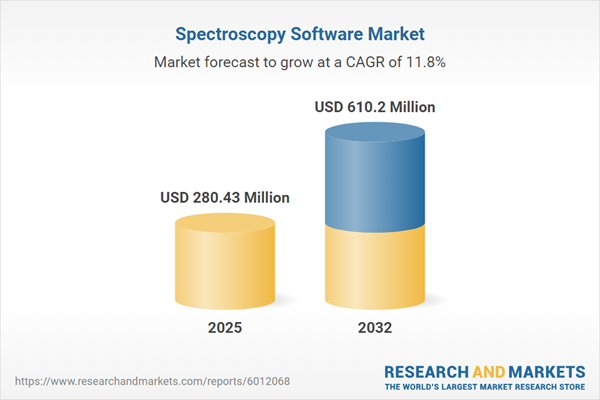Speak directly to the analyst to clarify any post sales queries you may have.
The Spectroscopy Software Market is rapidly evolving, driven by technological innovation and rising demands for analytical precision across critical industries. As organizations seek efficient solutions to streamline molecular analysis and data interpretation, advanced software platforms are essential for sustaining competitiveness and operational agility.
Market Snapshot of the Spectroscopy Software Market
The Spectroscopy Software Market grew from USD 250.88 million in 2024 to USD 280.43 million in 2025, with an anticipated CAGR of 11.75% through 2032. At this trajectory, the market is forecasted to reach USD 610.20 million by 2032, underscoring significant momentum among industrial, research, and regulatory users seeking sophisticated analytical capabilities.
Scope & Segmentation
This report examines core opportunities and challenges in the spectroscopy software arena, spanning key end users, technologies, applications, company scales, and global geographies:
- Deployment Modes: Cloud (IaaS, PaaS, SaaS), On-Premise (Client Server, Standalone).
- Company Sizes: Large Enterprise, Small Medium Enterprise.
- Applications: Material Characterization, Process Monitoring, Quality Control, Research Development.
- End Users: Academia, Chemical, Environmental, Food Beverage, Pharmaceuticals.
- Geographic Regions: Americas (United States, Canada, Mexico, Brazil, Argentina, Chile, Colombia, Peru), Europe, Middle East & Africa (United Kingdom, Germany, France, Russia, Italy, Spain, Netherlands, Sweden, Poland, Switzerland, United Arab Emirates, Saudi Arabia, Qatar, Turkey, Israel, South Africa, Nigeria, Egypt, Kenya), Asia-Pacific (China, India, Japan, Australia, South Korea, Indonesia, Thailand, Malaysia, Singapore, Taiwan).
- Technology Types: Advanced algorithms, cloud-native architectures, artificial intelligence (AI), machine learning, digital twins, open-source frameworks.
- Key Vendors Covered: Thermo Fisher Scientific Inc., Agilent Technologies Inc., PerkinElmer Inc., Shimadzu Corporation, Bruker Corporation, HORIBA Ltd., Malvern Panalytical Ltd, Metrohm AG, Rigaku Corporation, Ocean Insight Inc.
Key Takeaways for Senior Decision-Makers
- The market’s direction is shaped by the growing interdependence of AI-driven analytical processes and user-centric interfaces, yielding accelerated time-to-insight.
- Digital transformation is enabling real-time data monitoring, predictive diagnostics, and automated reporting—now threshold expectations for end users.
- Organizations increasingly prioritize platforms offering workflow reproducibility, regulatory compliance, and strong data traceability, especially in highly regulated sectors.
- Regional adoption patterns hinge on infrastructure maturity, policy frameworks, and local industry needs, requiring tailored deployment and integration strategies.
- Collaborative ecosystems and open-source contributions are broadening solution diversity, enabling flexible customization and scalable implementations.
Tariff Impact on Supply Chains and Costs
Recent US tariff measures affecting critical software components have introduced new procurement and pricing challenges for spectroscopy software stakeholders. Leading firms are countering these pressures by localizing development, diversifying supplier networks, and renegotiating service contracts to manage volatility. Increased investments in open-source and bespoke solutions reflect strategic efforts to mitigate operational cost escalation and strengthen supply chain resilience over time.
Methodology & Data Sources
This analysis leverages a hybrid research design that integrates expert interviews and structured user surveys with rigorous secondary review of technical publications, patents, and regulatory documentation. Validation through triangulation and statistical mapping ensures precision and actionable value for executive audiences.
Why This Report Matters for Decision-Makers
- Enables well-informed technology selection, integration roadmaps, and investment prioritization aligned to organizational strategy.
- Equips teams with deep comparative insights across segments, deployment modes, and vendor capabilities to optimize ROI and long-term success.
- Highlights the strategic implications of external policy shifts and regulatory changes on solution delivery and business resilience.
Conclusion
With digital transformation accelerating and policy landscapes shifting, effective adoption of spectroscopy software is essential for organizations seeking operational excellence and sustainable competitiveness. This report equips senior leaders with the critical perspectives needed for confident, forward-looking decisions in a dynamic global market.
Additional Product Information:
- Purchase of this report includes 1 year online access with quarterly updates.
- This report can be updated on request. Please contact our Customer Experience team using the Ask a Question widget on our website.
Table of Contents
3. Executive Summary
4. Market Overview
7. Cumulative Impact of Artificial Intelligence 2025
Companies Mentioned
The companies profiled in this Spectroscopy Software market report include:- Thermo Fisher Scientific Inc.
- Agilent Technologies, Inc.
- PerkinElmer, Inc.
- Shimadzu Corporation
- Bruker Corporation
- HORIBA, Ltd.
- Malvern Panalytical Ltd
- Metrohm AG
- Rigaku Corporation
- Ocean Insight, Inc.
Table Information
| Report Attribute | Details |
|---|---|
| No. of Pages | 185 |
| Published | October 2025 |
| Forecast Period | 2025 - 2032 |
| Estimated Market Value ( USD | $ 280.43 Million |
| Forecasted Market Value ( USD | $ 610.2 Million |
| Compound Annual Growth Rate | 11.7% |
| Regions Covered | Global |
| No. of Companies Mentioned | 11 |









